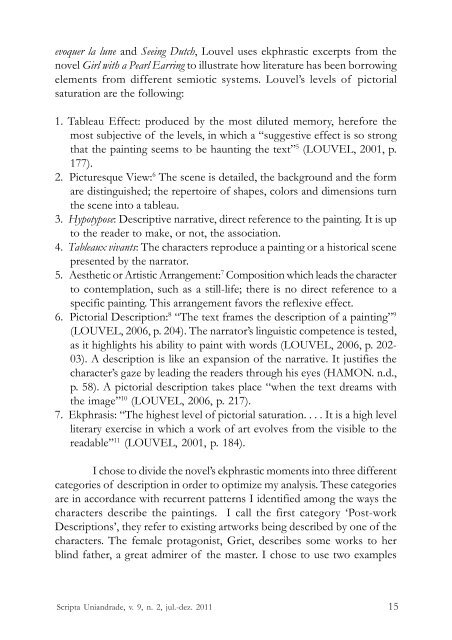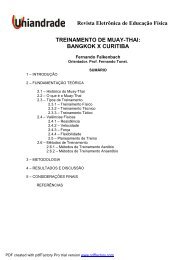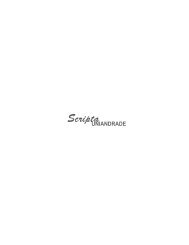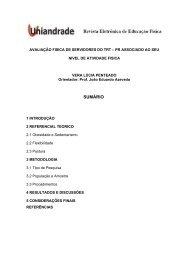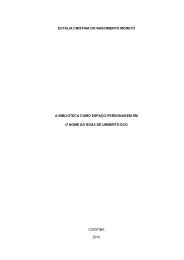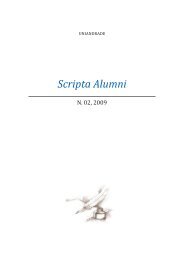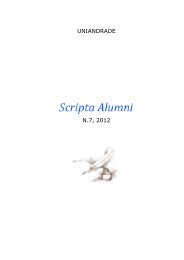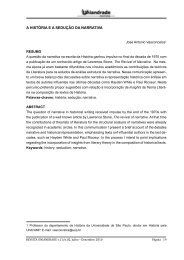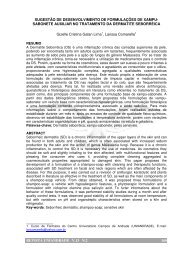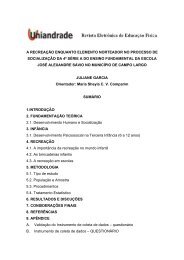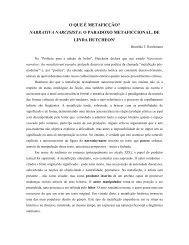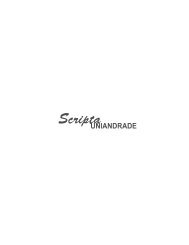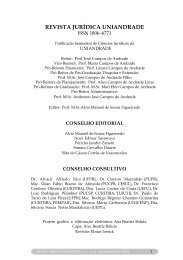Scripta 9_2_link_final.pdf - Uniandrade
Scripta 9_2_link_final.pdf - Uniandrade
Scripta 9_2_link_final.pdf - Uniandrade
Create successful ePaper yourself
Turn your PDF publications into a flip-book with our unique Google optimized e-Paper software.
evoquer la lune and Seeing Dutch, Louvel uses ekphrastic excerpts from the<br />
novel Girl with a Pearl Earring to illustrate how literature has been borrowing<br />
elements from different semiotic systems. Louvel’s levels of pictorial<br />
saturation are the following:<br />
1. Tableau Effect: produced by the most diluted memory, herefore the<br />
most subjective of the levels, in which a “suggestive effect is so strong<br />
that the painting seems to be haunting the text” 5 (LOUVEL, 2001, p.<br />
177).<br />
2. Picturesque View: 6 The scene is detailed, the background and the form<br />
are distinguished; the repertoire of shapes, colors and dimensions turn<br />
the scene into a tableau.<br />
3. Hypotypose: Descriptive narrative, direct reference to the painting. It is up<br />
to the reader to make, or not, the association.<br />
4. Tableaux vivants: The characters reproduce a painting or a historical scene<br />
presented by the narrator.<br />
5. Aesthetic or Artistic Arrangement: 7 Composition which leads the character<br />
to contemplation, such as a still-life; there is no direct reference to a<br />
specific painting. This arrangement favors the reflexive effect.<br />
6. Pictorial Description: 8 “The text frames the description of a painting” 9<br />
(LOUVEL, 2006, p. 204). The narrator’s linguistic competence is tested,<br />
as it highlights his ability to paint with words (LOUVEL, 2006, p. 202-<br />
03). A description is like an expansion of the narrative. It justifies the<br />
character’s gaze by leading the readers through his eyes (HAMON. n.d.,<br />
p. 58). A pictorial description takes place “when the text dreams with<br />
the image” 10 (LOUVEL, 2006, p. 217).<br />
7. Ekphrasis: “The highest level of pictorial saturation. . . . It is a high level<br />
literary exercise in which a work of art evolves from the visible to the<br />
readable” 11 (LOUVEL, 2001, p. 184).<br />
I chose to divide the novel’s ekphrastic moments into three different<br />
categories of description in order to optimize my analysis. These categories<br />
are in accordance with recurrent patterns I identified among the ways the<br />
characters describe the paintings. I call the first category ‘Post-work<br />
Descriptions’, they refer to existing artworks being described by one of the<br />
characters. The female protagonist, Griet, describes some works to her<br />
blind father, a great admirer of the master. I chose to use two examples<br />
<strong>Scripta</strong> <strong>Uniandrade</strong>, v. 9, n. 2, jul.-dez. 2011 15


